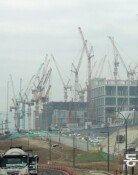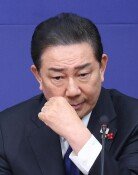Local gov¡¯t budgets lack planning
Local gov¡¯t budgets lack planning
Posted November. 22, 2000 15:39,
The extravagance bordering on outright wastefulness of local autonomous governments has worsened.
Many have begun development projects without detailed feasibility studies, and in the name of city planning and development, they have haphazardly supported construction works without a solid vision.
Many of the so-called profit-turning investments have become tripping stones that drain the finance of the local autonomous governments. On the other hand, some local governments have supported unnecessary work projects in fear of under-spending the budget and receiving lower budget allocations next year.
Lack of vision:
The city of Kwangju has plans to destroy the 386-meter Baik-un Overpass, which was completed in December 1989 at a cost of 10 billion won. In its place, another overpass, 100 meters long, will be built at a cost of 20 billion won.
The city of Kwangju decided to destroy the 10-year old overpass, which alleviates the traffic for vehicles headed out toward the southwestern area of the Chungnam region, because the city planners failed to make proper analysis and predictions of the increase in traffic in the area marked out for development.
With the establishment of large-scale residential housing such as Keumho and Pung-am for about 50,000 individuals, the overpass already had become obsolete.
Reckless business ventures:
The Kangwon Public Development Enterprise invested 19 billion won in June 1996 to obtain and develop 171,000 pyong for residential housing in the Hongchon area. However, today four years later, 28% of the developed land has not been sold.
Although the Public Development Enterprise had an ambition of turning a profit on the project, many foresee the long economic stagnation to prevent the sale of the unsold plots making it difficult for Kangwon Province to even break even.
"When they first began their land development project, the city and wards nearby had many unsold plots of land," an experts in land development said. "It is difficult to understand why the local government even started the project."
In the case of the city of Masan in Kyongnam Province, without having obtained any guarantee for funding for the project, the city began a 68.7 billion won project in 1997 to build a 74,000-pyong manmade beach resort and park in Myongju. The project was due to be completed by 2001 but has not had much progress as of today. The city of Masan already has laid down 1.3 billion won for the land and has been searching for funding the project. However, with the expected profit from the proposed theme park minimal and the economic situation weak, the city has failed to find any investor.
Lack of prior coordination:
The Chonju Education Board in Chonbuk Province, in the name of saving cost in building new schools, submitted a proposal and application to build middle schools within the land held by five elementary schools. However, their proposal was turned down.
The city revealed that of the five schools, four of them were within the same school district, which would require many middle school students living away from the district to travel a long distance. The city also faced stiff opposition by the residents of new towns including Sokok area, who expected a middle school near their neighborhoods. The city's Education Board wasted the 450 million won on planning.
Haphazard budget spending:
In case of the city of Suhguipo on Cheju Island, the city proposed to clean up its bathroom facilities and sought a budget of 340 million won for next year. The city planned to tear down the 29-pyong bathroom beside the parking facility at the Chonjiyon Waterfall and resurrect a new one.
However, with the assessment that the existing bathroom was good enough to have received first prize in the 1998 "clean bathroom facility" contest sponsored by the Korea National Tourism Organization, the city quickly overhauled the plan and opted for renovation.
Lack of expertise:
The city of Ulsan planted cherry trees along the roads near the Korean pear orchards. However, upon hearing that from the U.S. importer of Korean-pears that "the cherry trees transmit parasites that harm the pears," the city of Ulsan replanted the roadside trees after two years of original planting.
In March 1998, the city invested 78 million won to plant 805 cherry trees along the six kilometers of the road, which stretches from Hwasan-ri to Onyang-myon. However, during the trade talks for the Korean pears grown in Ulsan, the U.S. importers stipulated that the 200-meter range of the pear orchard must be free of all host trees or vegetation that could transmit disease, such as the cherry trees, to the pears. To comply, the city needed 50 million won to pull up and transplant the cherry trees elsewhere, and 66 million won more was needed to plant 620 gingko trees along the road.
"We planted the cherry trees because we did not know that the cherry trees could play host to disease that could harm the pears," a city official explained.







